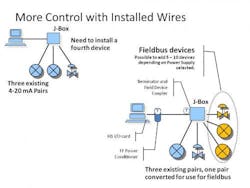Wireless is being proposed as the easiest and lowest cost way to install additional infrastructure between a field device and the control system when the home run cable is ‘full.’ Unfortunately, this is not true since as the title implies another alternative exists and that alternative can be used in any area classification. The solution is Fieldbus. Because fieldbus protocols are wired in parallel and support multiple connections on a single home run (trunk) cable, provided the cable is capable of carrying a fieldbus signal it can be converted from analog to digital communications service while providing ALL the benefits of a wired connection while using open standard technologies proven in use for over a decade. Now to describe how this can be done.
The first step is to confirm that the existing cable will support a fieldbus message by using a paired signal generator and network analyser to put a signal on the network. Relcom Inc. (http://www.relcominc.com/fieldbus/fbtesters.htm) makes a pair of such devices. The FBT-5 is a signal generator while the FBT-6 is a network analysis tool. Because the Fieldbus specification was designed to be able to use existing cable, I have yet to run a test with these tools that did not pass. Once the cable has been confirmed as acceptable, the next requirement is to confirm that your control system supports an H1 I/O card as you will need to install a card in your Host to be able to communicate with the new Fieldbus devices. If your Host does not support H1 directly, there are other alternatives but then things get more complicated with OPC and such starting to get involved but the basic concept described here will still work. Besides if the Host does not support native H1, I imagine it is unlikely to directly support Wireless either.
End result, fully integrated digital transmitters complete with diagnostics, power and compliant with a widely supported international standard.





